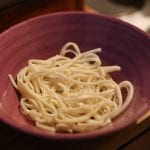Ramen is a type of Japanese noodle made from wheat flour that can be purchased in Asian supermarkets or online in a variety of ways, whether fresh, pre-cooked, dried or as instant noodles. Like other Japanese noodles – among the most important besides ramen are udon and soba noodles – the Japanese like to eat them cold or hot, as a side dish with other dishes or just as a soup. Originally, ramen is a Chinese soup that found its way into Japanese cuisine in the 19th century and is now popular all over the world.
Japanese noodle soup made from ramen has the same name and differs depending on the broth used and the garnishes. The broth is made from chicken or pork meat or bones.
Probably the most common type of shoyu is dressed with a soy sauce, but there are other variations, such as ramen as miso soup (miso is a soybean paste). Miso soup is a Japanese national dish, main ingredients are miso and dashi, which is fish broth. Shio, on the other hand, is a salty version and is made from fish and seafood, while tonkotsu is made from cooking pork for hours.
Sides in the soup often include various types of meat and fish, eggs, and crunchy vegetables such as spring onions, bamboo shoots, and seaweed.
In Tokyo and throughout Japan, there are countless restaurants and snack bars that serve ramen (often exclusively) – and almost each and every one of them has its own ramen recipe. This also means that there are a variety of ramen in Japan and they all have different tastes.







